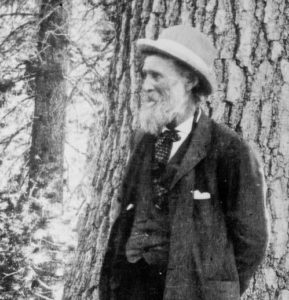
““Climb the mountains and get their good tidings, Nature’s peace will flow into you as sunshine flows into trees. The winds will blow their own freshness into you and the storms their energy, while cares will drop off like autumn leaves.”
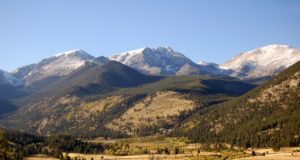
Thus spoke John Muir back in 1883. Feeling this same emotional tug, off to the Rocky Mountains of Colorado Anne and I did go. As flat-landers born and raised in the Wabash River valley of Indiana, I’ve often wondered about the source of the mystical pull the mountain west now seems to exert upon us with alarming frequency.
Our rural Indiana country does have its charms. The deciduous forests, spring and fall in particular, are lovely. There are lakes and streams to float, fish, and admire. But we sure have our share of corn and soy beans too. Indiana has been pretty much tamed I’m afraid. And there are oodles of people here too, about 48 per square mile. Granted, this is nearly the same demographic as when I was in high school back in the ‘60’s but it is downright crowded compared to the average of four people per square mile in the Rockies. The relative wildness, the solitude, the separation from routine worries, a softness not marred by unnatural sounds could all be reasons an escape to the mountains is so appealing. Yes, “nature’s peace will flow into you . . ..”
We always eagerly anticipate arising that first morning in the mountains. 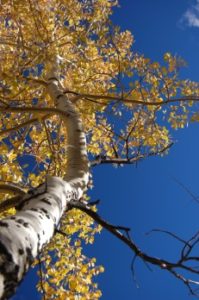 Certainly there is excited expectancy for the adventures to come. But there is also the palpable, physical reality of being in the high country. It is marked by that first breath, scented heavily with the fragrance of pine, spruce, and fir. It is the sensation of a dry, chilled, crystal-clear mountain air upon the face as one first steps outside the cabin. It is the vision of a sky rendered so stunning that one is left to ponder just what the correct word might be for a blue so deep, so splendidly beautiful. Here are more reasons we often hear the mountain’s call I suspect.
Certainly there is excited expectancy for the adventures to come. But there is also the palpable, physical reality of being in the high country. It is marked by that first breath, scented heavily with the fragrance of pine, spruce, and fir. It is the sensation of a dry, chilled, crystal-clear mountain air upon the face as one first steps outside the cabin. It is the vision of a sky rendered so stunning that one is left to ponder just what the correct word might be for a blue so deep, so splendidly beautiful. Here are more reasons we often hear the mountain’s call I suspect.
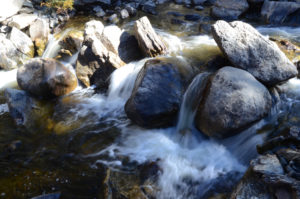 Another charm offered within the mountains is their boulder-strewn, rushing streams. Singing their melodies with roaring abandon, they plunge downward seeming disgruntled at having to wait for their rendezvous with the great seas. Why does the rush of water over stone mesmerize us so? Does their roaring overpower other sounds and, like an isolation booth, allow our thoughts to turn undistractedly and reflectively inward? Is it the one hundred fascinating pathways the water charts through its stony bed that enthralls us? Here the water plunges over a hidden boulder and forms a miniature standing wave just downstream. There the water is forced through a tiny passage between two stones and warbles its displeasure at this fruitless attempt to be held back. In another spot, the water flows over a ledge and forms a curtain of watery icicles, white and yet as translucent as crystal they are.
Another charm offered within the mountains is their boulder-strewn, rushing streams. Singing their melodies with roaring abandon, they plunge downward seeming disgruntled at having to wait for their rendezvous with the great seas. Why does the rush of water over stone mesmerize us so? Does their roaring overpower other sounds and, like an isolation booth, allow our thoughts to turn undistractedly and reflectively inward? Is it the one hundred fascinating pathways the water charts through its stony bed that enthralls us? Here the water plunges over a hidden boulder and forms a miniature standing wave just downstream. There the water is forced through a tiny passage between two stones and warbles its displeasure at this fruitless attempt to be held back. In another spot, the water flows over a ledge and forms a curtain of watery icicles, white and yet as translucent as crystal they are.
I see a shadowy form lurking in the pool below this curtain.  A cutthroat trout perhaps? The presence of this icon of the mountain stream reminds me that such freely running waters are not just beautiful; they are home to a plethora of unique species. Yes, I would say a mountain stream helped draw John Muir westward as surely as it lures us today.
A cutthroat trout perhaps? The presence of this icon of the mountain stream reminds me that such freely running waters are not just beautiful; they are home to a plethora of unique species. Yes, I would say a mountain stream helped draw John Muir westward as surely as it lures us today.
Of course one must get out of the car while visiting the mountains; there is 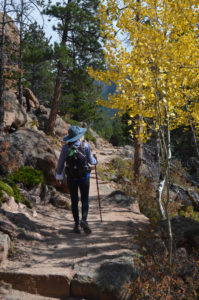 hiking to be done. To become truly infected with the bug that drives a person back into the heights again and again, these domains must be experienced through close contact. But be forewarned, some of this interaction will require work. Hiking in the mountains will, as one might suspect, require that substantial time be spent climbing upwards. The
hiking to be done. To become truly infected with the bug that drives a person back into the heights again and again, these domains must be experienced through close contact. But be forewarned, some of this interaction will require work. Hiking in the mountains will, as one might suspect, require that substantial time be spent climbing upwards. The  Rockies, Cascades, Santa Catalinas, and Wasatch ranges have all tested our endurance. Truth be known, there are times when I wonder whether or not I am having fun. There are stretches of trail where the walk is reduced to simply, mechanically putting one foot in front of the other. But then, at the end of a taxing climb, I find myself staring out at an alpine panorama such as Bierstadt Lake in Rocky Mountain National Park and it all seems so worthwhile. Admittedly, our hike may have encompassed what others might consider a short jaunt of five or six miles. Nevertheless, now well into our 70’s, perhaps allowing ourselves a small, self-congratulatory pat on the back is justified. The testing of one’s limits, the sense of accomplishment at the end of a tough slog are further rewards offered by the highlands. They are likely another reason we hear the mountain’s siren call.
Rockies, Cascades, Santa Catalinas, and Wasatch ranges have all tested our endurance. Truth be known, there are times when I wonder whether or not I am having fun. There are stretches of trail where the walk is reduced to simply, mechanically putting one foot in front of the other. But then, at the end of a taxing climb, I find myself staring out at an alpine panorama such as Bierstadt Lake in Rocky Mountain National Park and it all seems so worthwhile. Admittedly, our hike may have encompassed what others might consider a short jaunt of five or six miles. Nevertheless, now well into our 70’s, perhaps allowing ourselves a small, self-congratulatory pat on the back is justified. The testing of one’s limits, the sense of accomplishment at the end of a tough slog are further rewards offered by the highlands. They are likely another reason we hear the mountain’s siren call.
As a zoologist, the mountains offer another realm of possibilities. There are  creatures here not to be seen in the low, flat, lands back home. The mountains offer a visual feast for anyone with an interest in wildlife watching. The higher altitudes may yield the sight of a bighorn sheep. The strength and agility whereby they navigate the steepest slopes and tiniest ledges defies imagination. The mule deer around Estes
creatures here not to be seen in the low, flat, lands back home. The mountains offer a visual feast for anyone with an interest in wildlife watching. The higher altitudes may yield the sight of a bighorn sheep. The strength and agility whereby they navigate the steepest slopes and tiniest ledges defies imagination. The mule deer around Estes 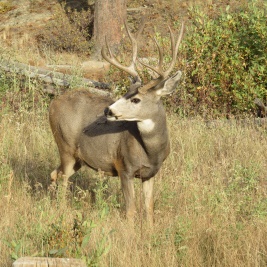 Park, handsome and in their prime, quite accommodatingly offer themselves as photo subjects by grazing along the roadsides. Be alert! They can as easily decide that the grass is greener across the way.
Park, handsome and in their prime, quite accommodatingly offer themselves as photo subjects by grazing along the roadsides. Be alert! They can as easily decide that the grass is greener across the way.
A hike in Rocky Mountain National Park provides a new cast of squirrel actors in comparison to our Indiana home. Pine squirrels, or chickarees, are common. They seem to be constantly at work harvesting conifer seeds or storing cones for the winter in their distinctive midden piles. Golden-mantled ground squirrels dart across the trail in their quest for seeds with which to build the fat reserves that will see them through the long, cold winter ahead. The smallest RMNP squirrel is the least chipmunk. Agile and prone to sudden darting movements, these little rodents have also 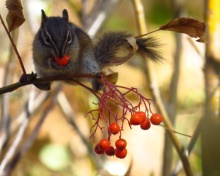 mastered the art of mooching around picnic areas. Their innate “cuteness” makes denying them a snack a tough decision. But, they do need to rely on their natural diet of seeds, fruits, and insects. Although we think of them as a “ground squirrel”, least chipmunks will quite happily ascend into an elderberry and dine on the ripe, red berries to be found there.
mastered the art of mooching around picnic areas. Their innate “cuteness” makes denying them a snack a tough decision. But, they do need to rely on their natural diet of seeds, fruits, and insects. Although we think of them as a “ground squirrel”, least chipmunks will quite happily ascend into an elderberry and dine on the ripe, red berries to be found there.
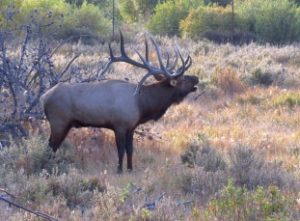 September’s biggest show is the elk rut, now at its peak during this month and the next. The park provides innumerable opportunities to simply sit and watch the fascinating by-play. There are dominant bulls striving to maintain their harems. Bachelor bulls lurk on the periphery and
September’s biggest show is the elk rut, now at its peak during this month and the next. The park provides innumerable opportunities to simply sit and watch the fascinating by-play. There are dominant bulls striving to maintain their harems. Bachelor bulls lurk on the periphery and 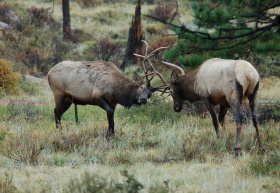 contemplate stealing a mate for themselves from among the comely herd. Some bulls, nearing prime adulthood, weigh their odds as they consider challenging an older male and thus usurping his harem. All in all, the spectacle may provide hours of entertainment and requires little besides binoculars, a desire to learn, and a
contemplate stealing a mate for themselves from among the comely herd. Some bulls, nearing prime adulthood, weigh their odds as they consider challenging an older male and thus usurping his harem. All in all, the spectacle may provide hours of entertainment and requires little besides binoculars, a desire to learn, and a 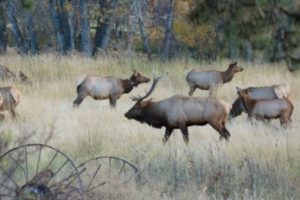 willingness to engage with another species. Being presented with one’s own, personal Animal Planet show is yet another reason to heed the mountain’s call.
willingness to engage with another species. Being presented with one’s own, personal Animal Planet show is yet another reason to heed the mountain’s call.
 Naturally, given the vast differences in altitude and habitat between home and the Rockies, there are plenty of opportunities to encounter a variety of less familiar birds. Steller’s and gray jays are typical
Naturally, given the vast differences in altitude and habitat between home and the Rockies, there are plenty of opportunities to encounter a variety of less familiar birds. Steller’s and gray jays are typical 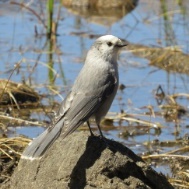 members of the mountain’s avifauna. Quite a few of them seem to have learned that hanging about a picnic table is an easy way to make a living. Black-billed magpies seem to be everywhere and could serve as avian representatives of the northwest. Occasionally one may even see a totally new species which can be added to one’s so-
members of the mountain’s avifauna. Quite a few of them seem to have learned that hanging about a picnic table is an easy way to make a living. Black-billed magpies seem to be everywhere and could serve as avian representatives of the northwest. Occasionally one may even see a totally new species which can be added to one’s so-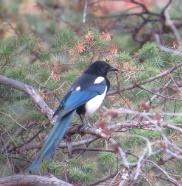 called life list. Such was our luck on this trip when we spotted an American three-toed woodpecker busily working away at the trunk of a dead pine. I suppose this particular bird may have, over time, been spotted by an army of previous hikers. But for us it was new and represented yet another small sweetener offered by a jaunt into the mountains.
called life list. Such was our luck on this trip when we spotted an American three-toed woodpecker busily working away at the trunk of a dead pine. I suppose this particular bird may have, over time, been spotted by an army of previous hikers. But for us it was new and represented yet another small sweetener offered by a jaunt into the mountains.
On our list of “must see” animals this time was the pika. After many excursions to the mountains and an equal number of failed attempts to see this fascinating little mammal, we were determined. A query to a park ranger immediately put a damper on our hopes. ” Yes,” he could recommend a good spot to see them but, “the tail end of September might be too late.” The cold temperature at their high-altitude home may have driven them to permanent winter shelter already. Remaining hopeful, we headed up Trail Ridge Road to a spot called the Rock Cut Overlook. Here, at this high elevation, there were talus slopes. Such inclines are composed of a jumble of rocks of various sizes which have fallen and accumulated at the base of a cliff or steep slope. Among these rock piles thrives the pika.
What a fascinating lifestyle these little (6”-8”) relatives of rabbits and hares live. During warm weather they cut grasses and wildflowers and lay them upon the talus rocks to sun-dry. Once dehydrated, this hay is carried down under the rocks to their den. Here it is stored for winter use as their home may become snow-covered and too cold to venture out.
Arriving at Rock Cut we donned extra layers of clothes, gloves, toboggan and ventured out onto the Tundra Community Trail. What a harsh landscape we encountered. The tree line rested well below us as we trod along at 12,178 ft. above sea level. Here was a hard-scrabble world of short grasses, lichen-covered rocks, and relentless wind. During the winter, icy blasts of over 100 mph can occur. Today’s wind gusted to 30 mph and easily penetrated our four layers of upper clothing. The temperature felt like 25F rather than the balmy 75F the folks down below in Estes Park were enjoying. I could only imagine the harshness of the winter at these heights. The thought left me incredulous that living organisms could eke out an existence up here.
In spite of the cold, we were in luck. A sudden darting scramble caught our eye and there, thirty yards away, perched atop a talus rock was a pika. 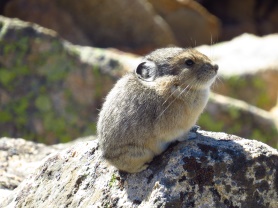 Facing downwind, its fur rustled in the gusty breeze allowing the cold breeze to penetrate to its skin. The pika quickly decided the den was a much better place to be today. But at least we had cast eyes upon our elusive quarry.
Facing downwind, its fur rustled in the gusty breeze allowing the cold breeze to penetrate to its skin. The pika quickly decided the den was a much better place to be today. But at least we had cast eyes upon our elusive quarry.
Of course we were unsatisfied with such a brief glimpse of our target animal and we came back two days later. Luck was with us and we saw more of the little lagomorphs. With warmer, less windy conditions they sunned themselves atop their rock perches within mere feet of us. Another gift had been bestowed upon us by the mountains. I hope my grandchildren’s children may one day chase the  dream of seeing a pika. On a warming planet their habitat is under threat. If their mountain-tundra world is heated and transformed, where will they go? Already living at 12,000 feet, they can’t move much higher.
dream of seeing a pika. On a warming planet their habitat is under threat. If their mountain-tundra world is heated and transformed, where will they go? Already living at 12,000 feet, they can’t move much higher.
Reflecting upon our recent trip to the Rockies has given me insight into the source of John Muir’s infatuation with the mountains. The mountains do offer their good tidings. These come in the form of unsurpassed scenic beauty, blissful solitude, and close encounters with the denizens of these high worlds, fellow passengers on our precious, blue, island of life. The wind will blow its own freshness into you. It carries within its breath the aroma of pine, the scent of rushing waters, a hint of wildness untrammeled by man. Nature’s peace will flow into you. Cares will drop off like autumn leaves. Yes, now that I think of it, it’s high time we started planning our next journey into the mountains
